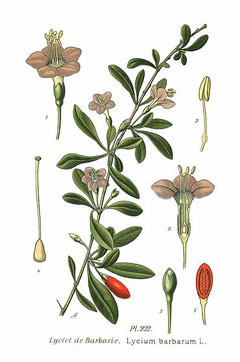
Goji, Box Thorn, Matrimony vine
Latin Name: Lycium barbarum
USDA Hardiness: 6-9
Native Range: TEMPERATE ASIA: China (Gansu Sheng, Hebei Sheng (north), Nei Mongol Zizhiqu, Ningxia Huizi Zizhiqu, Qinghai Sheng, Shanxi Sheng (north), Sichuan Sheng, Xinjiang Uygur Zizhiqu)
Edibility Rating: 4 / 5
Medicinal Rating: 3 / 5
Region:
Family:
Plant Type:
Medicinal Uses
Edible Uses
Edible Parts: Fruit Leaves Shoots | Edible Uses: TeaFruit - raw or cooked[2, 105, 146]. The fruit is a berry about 2cm in diameter[200, 206]. A mild sweet liquorice flavour[206]. Only the fully ripe fruits should be eaten[K]. Young shoots - cooked[2, 46, 85, 105]. Used mainly as a flavouring, they can also be lightly cooked for 3 - 4 minutes and used as a vegetable, the flavour is somewhat cress-like but has also been described as peppermint-like[206]. The leaves wilt rapidly once they have been harvested[206]. Some caution is advised, see notes at top of the page. The leaves are a tea substitute[183].
Cultivation
An easily grown plant, it does not require a rich soil, flowering and fruiting better in a well-drained soil of moderate quality[1, 200]. Succeeds in impoverished soils[200], but more fertile soils are best if the plant is being grown for its edible young shoots[206]. Requires a sunny position[200]. Some plants at Kew are growing well in light shade[K]. Tolerates maritime exposure[11, 49, 200]. Plants are hardy to about -15°c[202]. There are some named varieties, selected for their ornamental value[206]. Plants are very tolerant of pruning and can regrow from old wood[202]. Any trimming is best carried out in the spring[188]. Plants produce suckers freely and can become invasive when in a suitable position. Otherwise they can be difficult to establish[202]. There is much confusion over the naming of this species. Most, if not all, of the plants being grown as L. chinense or L. europaeum are in fact this species[11]. In garden design, as well as the above-ground architecture of a plant, root structure considerations help in choosing plants that work together for their optimal soil requirements, including nutrients and water. The root pattern is suckering with new plants from underground runners away from the plant [2-1]. Goji berries are usually harvested in late summer to early autumn when the berries are fully ripe and have turned bright red. Lycium species generally flower in late spring to early summer producing small, tubular flowers that can be purple or white. Lycium species are moderately fast-growing plants. Depending on growing conditions, they often reach a height of about 1 to 3 meters (3 to 10 feet) within a couple of years. Lycium species, including Goji berries, are self-fertile, meaning they can produce fruit from their own flowers.
Known Hazards
Although no records of toxicity have been seen, some caution should be exercised with this species, particularly with regard to its edible leaves, since it belongs to a family that often contains toxins. However, use of the leaves is well documented and fairly widespread in some areas. The unripe fruit might also be suspect though the ripe fruit is wholesome.
Habitats
Hedges, on walls and waste ground[17].
